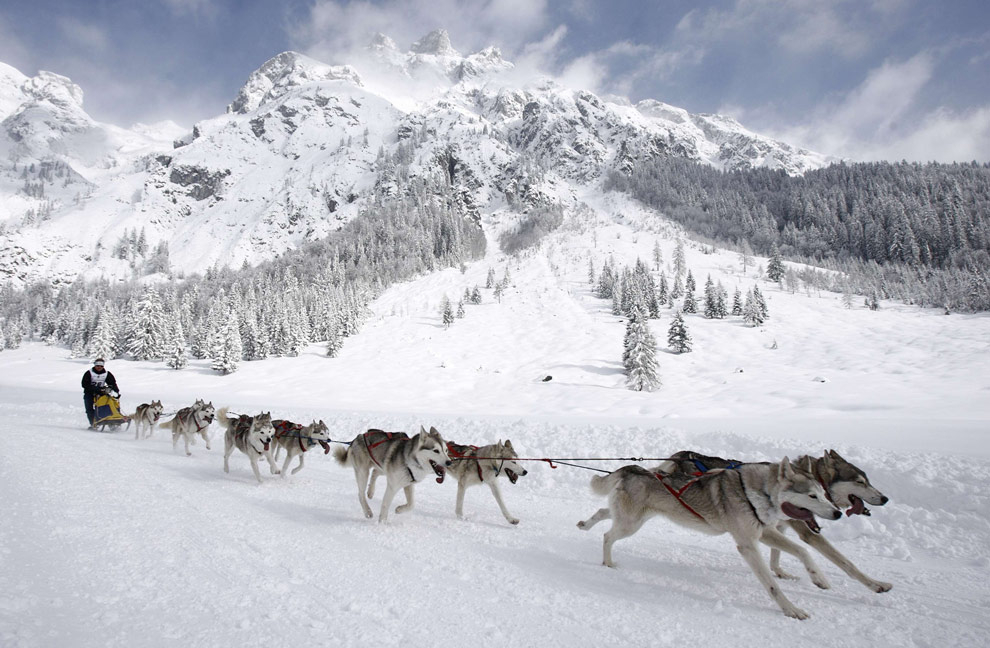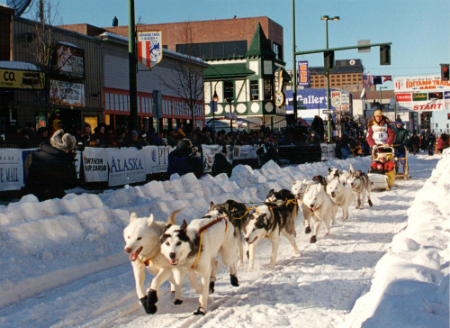1. Huskies were developed as working sled dogs over thousands of years by the Chukchi people living in the Siberian peninsula of northeast Asia.

The area is home to one of the most hostile and extreme climates in the world—where winds can reach 100 miles per hour and temperatures can drop to 100 degrees below zero. With teams of up to 20 dogs pulling their sleds out onto the ice in their search for food, the Chukchi relied on the dogs for survival, and the dogs were central to the people’s life and culture.
2. According to Chukchi belief, two Huskies guard the gates of heaven, turning away anyone who was cruel to a dog during their life on earth.
3. Siberian sled dogs were used by the U.S. Army during World War II for Arctic search and rescue of downed pilots and cargo. “Rescues of crews of planes which had crashed were often collaborations between search planes and sleds. First a recon plane would locate the wreck by the aid of radio, visual signals, or scouting. In flying back to the base, personnel on the plane would survey the quickest and safest approach for a dog team. A transport plane then loaded drivers, dogs and sleds, and landed them as close as possible to the scene of the disaster. Every minute gained was precious—the crew of the wrecked plane were likely to be injured, freezing, and starving.” (K9history.com)
4. The breed gained fame in 1925 after Siberian Husky sled dogs heroically brought lifesaving serum to fight a diphtheria epidemic in Nome, Alaska. The closest source of the medicine was more than 600 miles away, so a dog-team relay involving 20 "mushers" (sled-team drivers) and more than 100 dogs was formed to bring the serum as quickly as possible.
Musher Leonhard Seppala left Nome with 20 Siberians, heading east to meet a team coming from the other direction carrying the package of medicine. Seppala’s team had to go farther than expected, but after traveling 170 miles in three days they finally met the other team.
With the medicine on board, Seppala turned his tired team around, with lead dog Togo at the front, and they began back toward Nome as night fell amid gale-force winds and temperatures of 30 degrees below zero. As they attempted to cross the frozen Norton Sound, darkness and blizzard conditions prevented Seppala from seeing the route ahead, but Togo navigated the team to a roadhouse on the shore, probably saving the lives of all—and preventing loss of the precious serum. The last leg of the relay was completed by Gunnar Kaasen and his team, led by Balto.

News soon spread of the mushers’ heroic feats, and in 1926 Seppala was invited to tour the U.S. With more than 40 Siberian Huskies, including Togo, Seppala visited cities across the country, stopping in New York City, where the explorer Roald Amundsen presented Togo with a medal for his role in the serum relay at Madison Square Garden. Although Togo and the rest of Seppala’s team ran the longest and most hazardous leg, due to being leader of the final team Balto became the most famous dog of the run, and his statue now stands in Central Park.
Since 1973, the Iditarod Trail Sled Dog Race from Anchorage to Nome has been run annually in commemoration of the Serum Run. Mushers and dog teams cover the distance in nine to 15 days or more. A range of Northern breeds and crossbreeds participate, and every year a number of all-Siberian Husky teams compete.
5. Siberians are high-energy and extremely athletic, and they can be expert escape artists. This can make them very challenging to keep as pets. Because they love to run long distances, for their own good, they should never be off-lead in unfenced areas—and they should be microchipped in case they ever are lost.
6. The Siberian is naturally clean, and his dense coat that protects him against cold weather does not require any clipping or trimming. The coat does have a shedding period at least once a year, but the shedding can be kept under control with frequent brushing during that time.
7. The breed’s national club, the Siberian Husky Club of America, offers a Sled Dog Degree Program where Siberians can compete in sled dog races and earn titles.
8. The word husky comes from esky, a shortened version of Eskimo, a general word referring to Arctic peoples.
9. Despite the Siberian Husky’s wolflike appearance, the breed is very friendly toward people, strangers included—so much so that they don't tend to make very good guard dogs.
10. Finally, those eyes. Those amazing eyes. A Siberian can have brown eyes, blue eyes, one of each, or even parti-colored eyes.

Siberian Huskies can make wonderful companions. They are high-energy, independent thinkers with a knack for escaping and a love of running, so they're not the breed for everyone. To learn more about Siberian Huskies and whether the breed is right for you, visit Siberian Husky breed page and the breed’s national club, the Siberian Husky Club of America.
